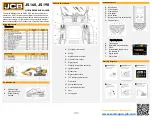
Foreword and general information
Handling of electric equipment
PC800, 850-8E0
Handling of electric equipment
00-26
(Rev. 2010/03)
To maintain the performance of the machine over a long period, and to prevent failures or other troubles be-
fore they occur, correct "operation", "maintenance and inspection", "troubleshooting", and "repairs" must be
performed. This section deals particularly with correct repair procedures for mechatronics and is aimed at im-
proving the quality of repairs. For this purpose, it gives sections on "Handling electric equipment".
Points to remember when handling electric equipment
00-26
1.
Handling wiring harnesses and connectors
Wiring harnesses consist of wires connecting
one component to another component, connec-
tors used for connecting and disconnecting one
wire from another wire, and protectors or tubes
used for protecting the wires.
Compared with other electrical components
fitted in boxes or cases, wiring harnesses are
more likely to be affected by the direct effects of
rain water, heat, or vibration. Furthermore,
during inspection and repair operations, they are
frequently removed and installed again, so they
are likely to suffer deformation or damage. For
this reason, it is necessary to be extremely
careful when handling wiring harnesses.
2.
Main failures occurring in wiring harnesses
1) Defective contact of connectors (defective
contact between male and female connec-
tors)
Problems with defective contact are likely to
occur because the male connector is not
properly fitted into the female connector, or
because one or both of the connectors is
deformed or the position is not correctly
aligned, or because there is corrosion or
oxidization of the contact surfaces. The
corroded or oxidized contact surfaces may
become shiny again (and contact may
become normal) by connecting and discon-
necting the connector about ten times.
2) Defective crimping or soldering of connectors
The pins of the male and female connectors
are attached to wires by crimping or
soldering. If excessive force is applied to the
wire, the joint is separated and causes a
defective contact or the wire is broken.
00-26











































